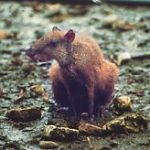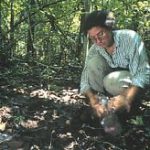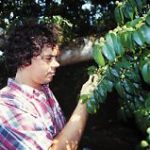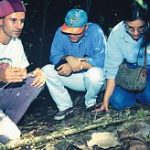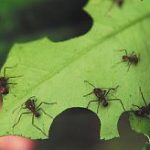Forest Dynamics
How does a forest change over time? In the late 1970´s, researchers argued about the stability of tropical forests and about the origins of so many different species in the same place.
Is it possible to predict how species change as climate changes? Will the same species that are present now be here in 100 years? How important are random events (like a migratory bird dropping seeds of a species from another area into the forest)?
Botanists measured, mapped and identified more than a quarter of a million trees (all of the trees with a basal diameter greater than about a half an inch (1 centimeter)) in a 50 hectare area on Barro Colorado in 1980. They repeated this census in 1985, 1990 and 1995.
Now we know how fast more than 400,000 trees grow, where different species of trees prefer to live (on slopes or in flat areas, in sun or shade, in moist or dry areas), and whether individual tree species are becoming more common or more scarce on the island. The fact that all of the trees have been identified makes life much easier for researchers. They can easily find out what species of tree is dropping seeds or fruit, what kind of leaves a monkey is eating, what species of tree a fungus is growing on.
Astrid Ferrer studies fungi that rot wood; very important in a forest where so much biomass is generated. Even huge dead trees like this one decay very quickly.
Greg Gilbert and Zuleyka Maynard worked on a project sponsored by Sandoz pharmaceuticals to isolate fungi from plants and soil that might produce medicinal compounds.
Currently a large group of people including staff from STRI, the University of Utah, the University of Panama and Gorgas laboratories are beginning a similar project to look for medicinal compounds in plants.
Elizabeth Losos (Project director) and Richard Condit (Former STRI staff) direct a large project to establish sites like the 50 ha plot in other tropical forests in the world.
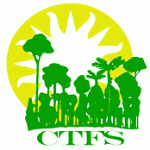
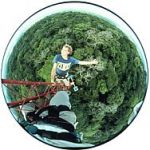
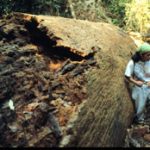

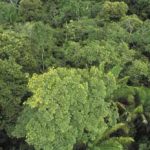
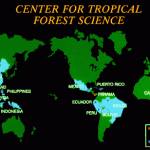
Life at the top
Getting there: A construction crane in Panama City’s Metropolitan Park carries scientists up into the tree tops.
Greg Gilbert (visiting scientist) prefers to use mountain climbing gear to reach the highest branches.
Gerhard Zotz (visiting scientist) measures photosynthesis from the construction crane: Intense tropical sunlight makes the forests here some of the most productive plant communities in the world.
Very little light reachs the soil under the canopy. Bettina Englebrecht (graduate student) is interested in the ability of plants to survive in different environments.
Milton Garcia (research technician) collecting insects: An amazing variety of insects, some of them still unknown, live in this leafy world.
A kinkajou…some of the animals living in the tree tops are almost never seen on the forest floor.
Cactuses, orchids and other plants that can survive a dry season with almost no water live on tree branches. Patricia Bermejo (project assistant) records information about greenhouse-grown plants.
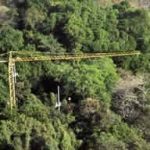
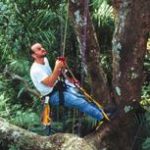
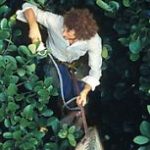
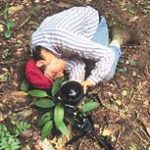
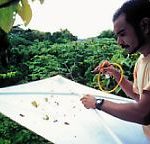
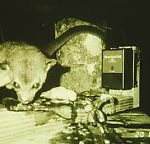
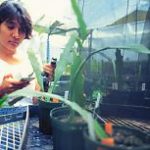
Seasonality
Tabebuia guayacan, the Guayacan tree, usually produces big yellow flowers in March or April, with the first rains at the end of the dry season. Above, you see the crowns of several trees that stand out above the forest like big flowers in a field of grass. Below, the flowers on the forest floor provide a clue to events high above in the treetops.
Prioria seeds are produced two times per year.
Jim Dalling, STRI postdoctoral fellow, places these huge seeds in trays of soil in the greenhouse to find out how long it takes for them to germinate.
For Jim and his assistant, Katia Silvera, to collect seeds, they need to know at what time of year the seeds are produced and when they will fall to the ground.
Some trees produce new leaves all year round. Others produce new leaves in a single “flush”. These baby leaves have a red pigment that helps to protect them from organisms that would like to eat them while they are still young and tender.
Dipteryx trees flower from May to August and are one of the only trees to produce fruit in the early dry season (January). Animals such as squirrels may starve if Dipteryx does not produce enough seeds.
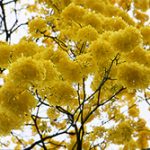

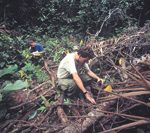
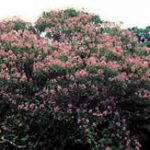
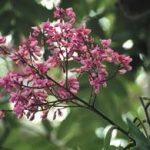
The greenhouse effect
On Barro Colorado, several research programs explore the effects of changes in the levels of greenhouse gasses. It is important to do these studies in the tropics, where most of the world’s plant biomass is located.
Every year we pollute the earth’s atmosphere with huge quantities of carbon dioxide (CO2)
The amount of CO2 in the atmosphere increased by 27% in the last 150 years and is expected to DOUBLE by the middle of the 21st century.
Carbon dioxide forms a “roof” over the earth’s surface. Sunlight can still come in, but heat can’t get out.
This is called the GREENHOUSE EFFECT. As it gets worse, we may expect:
- higher than normal temperatures
- severe weather patterns
- melting polar ice that results in rising sea levels
When we cut down tropical forests more CO2 remains in the atmosphere, making the greenhouse effect worse.
Plants “eat” carbon dioxide. They use energy from the sun to change it into carbohydrates. This process is called photosynthesis.
Tropical forests “eat” a lot of carbon dioxide.
If we double the amount of CO2 in the atmosphere, will plants eat twice as much and grow twice as fast as they do now?
This high CO2 garden simulates a “natural” plant community. Plants in a community may react differently than isolated plants grown in pots.
Graduate student Juan Posada and Catherine Lovelock (post doctoral fellow, Above) measure the rate of photosynthesis of plants in these chambers, which are supplied with different levels of CO2.
Plants grown in high CO2 environments often have thicker leaves that may decompose more slowly than leaves grown in normal CO2.
Insects and other animals may have to eat more high carbohydrate leaves to get the same levels of protein and other nutrients that they need.
Catherine Lovelock and Damond Kyllo (graduate student) with assistant, Virginia Velez, showed that the roots of plants grown in high carbon dioxide environments have more mycorrhizae, a type of fungus that lives on the roots of plants and help the plant to absorb more nutrients.
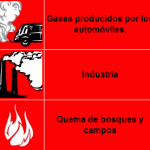
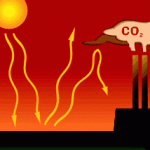
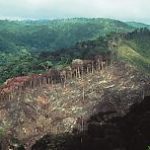
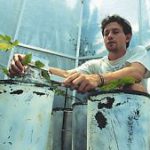
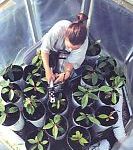
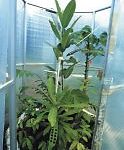
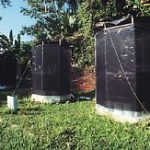
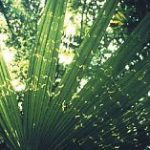
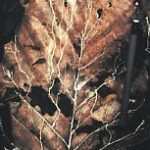
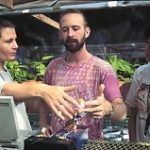
How to identify a plant
The first Flora of Barro Colorado Island was published in 1927 by Paul Stanley. The most recent Flora was published by Tom Croat in 1978.
There are 1,369 plant species listed in the 1978 Flora of Barro Colorado Island. Barro Colorado is one of only a few areas of tropical forest in the world where all of the plants have been identified. This is a photo of Tom Croat on a rainy day.
- Obtain a collection permit.
- Look for the plant you are interested in.
- Observe the plant carefully and note:
- where is it growing?
- what color are its fruits, its leaves, its flowers?
- how does it smell?
- how big is it?
- does it have spines, glands, or other structures?Carmen Galdames, herbarium worker, records information about dried plant specimens.
Carmen uses a dissecting microscope to examine a plant as she tries to identify it.
Blanca Arauz mounts dried specimens on herbarium paper
- Take a photo or draw a picture. These drawings were made by Rolando Pérez, a plant researcher on Barro Colorado.
- Collect samples of all of the parts of the plant: leaves, flowers, fruit.
- Place the plant in a PLANT PRESS between two sheets of newspaper.
- Put the press in a PLANT DRIER, a warm cabinet which dries the specimens slowly.
- Mount the dried plant on an HERBARIUM SHEET a large piece of white paper.
- Place a LABEL on the sheet with all of the information that was collected about the plant.
- Study the dried plant and compare it to other specimens in other collections. Use a description of plants called a FLORA to help you to identify your specimen.You may discover a new species!
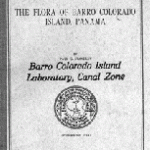
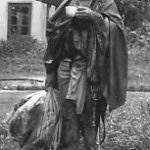
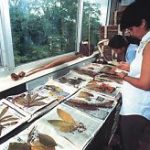


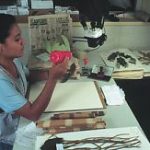
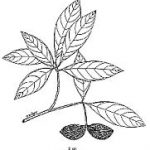
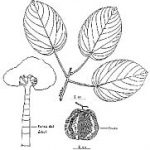
Plant – animal Interactions
When the Dipteryx tree drops its fruit, the agouti burys some seeds to eat later.These seeds may escape from insects and other animals that would like to eat them. Burried seeds may be the only seeds to grow into new trees.
In areas where people have killed all of the agoutis, tree species like Dipteryx become more and more rare.
Monica Mejia (project assistant) ties strings to seeds so that she can see how far they are moved by animals.
Without the tiny wasps that enter a fig fruit to pollinate the flowers inside, fig trees would also become more scarce, depriving monkeys, peccaries, bats and other forest animals of an important source of food.
Allen Herre studies interactions between figs, the wasps that pollinate them, and the tiny nematodes that may kill the wasps.
Rainer Wirth (doctoral student) shows visitors a line of leaf cutter ants carrying leaves from a tree to their nest.
Leaf cutter ants climb to the tops of trees to harvest the leaves that they use to fertilize the fungus growing in their nest. The holes that they cut in the canopy allow more light to reach plants growing below.
